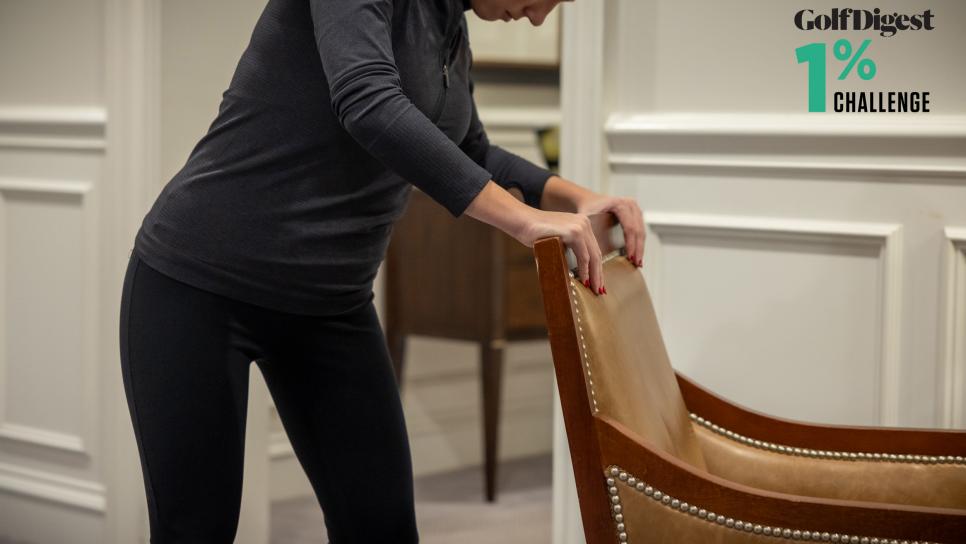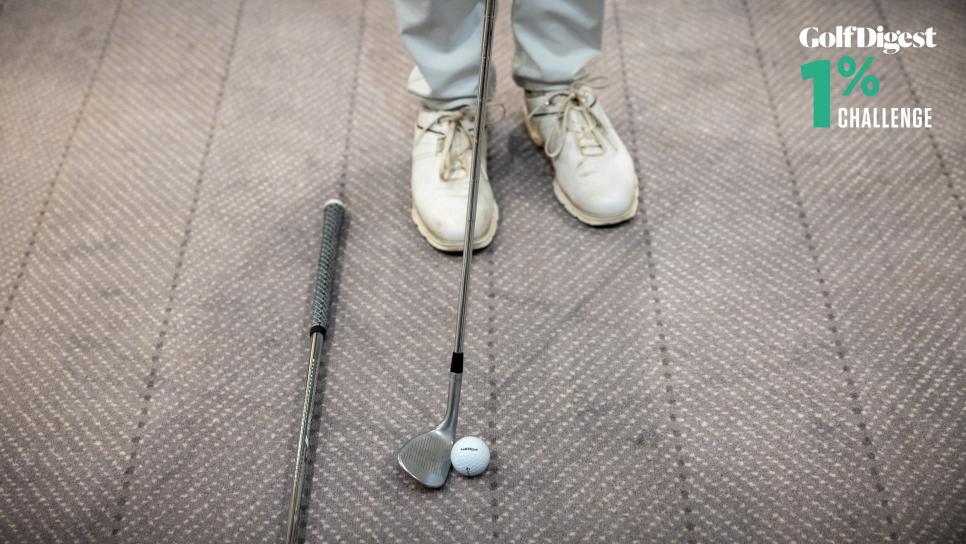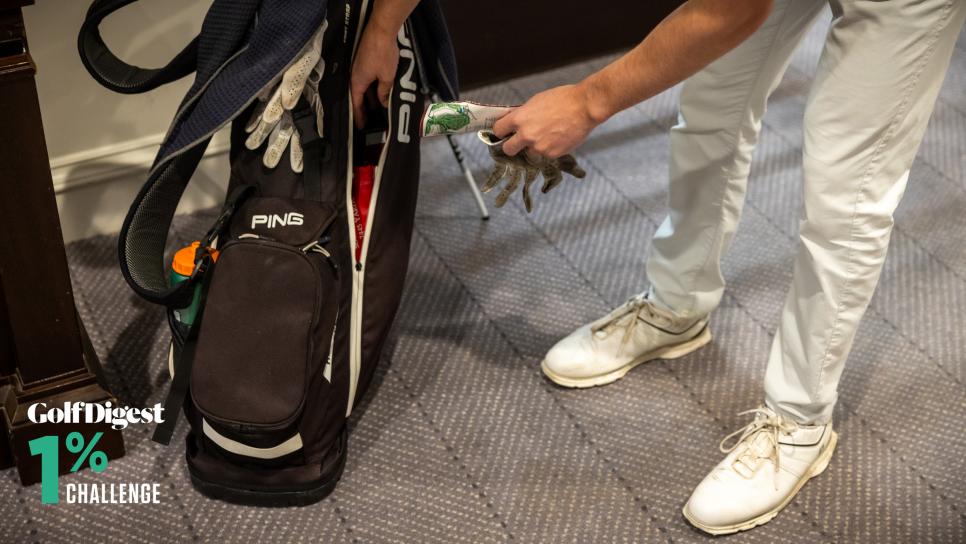New Year, New You
1 Percent Challenge: Find your ideal swing model

Editor’s Note: The Golf Digest 1 Percent Challenge will present a new challenge every weekday in January. Catch up on Week 1 and Week 2 here.
The beauty of golf swings are in their differences. Yet so often, amateur golfers forget that fact. They look at their own golf swings and think about all the idiosyncrasies they don’t like, and envy the moves of others they wish they had. The truth is studying the swings of others is a gift and a curse. A swing that may work for one player may not work for you. The reason why is actually quite simple: Everyone has different bodies, which influence the way we’re naturally inclined to swing the golf club.
The Solution: Finding a player whose golf swing you aspire to is a good thing—as long as you find the right one. You can start by simply finding players who look like you. Are you tall and heavyset, or short and slim? Things like arm length can alter a golf swing’s appearance, too. Golfers with longer arms will tend to swing the club more up-and-down, as Golf Digest Top 50 Teacher Mike Adams explains here. Players with a shorter wingspan will tend to move the club flatter, and more around their body,
Today: Look at a video of your golf swing and ask yourself three questions: What is your build? Is your right hand grip more on top of the club, or more to the side of the club, at setup? And does your left arm tend to work flatter (more under your right arm, when looking down the line) or above your right shoulder at the top of the backswing? Finding a pro who mirrors all two or three of your qualities is a good starting point for finding a swing model.
And then . . . : There's a deep rabbit hole you can dive into on this. But the more into it you get, the more you can start screening yourself. Measure your exact height and wingspan, then work your way through the Titleist Performance Institute's screens (ideally under the watchful eye of a trainer or coach) which will test the various strengths and inflexibility in your body. The more you'll learn about your own body, the more the best swing for you will reveal itself. —Luke Kerr-Dineen
Day 14: A tour-proven stretch to upgrade your turn

A key component of a good golf swing involves different parts of your body moving in opposing directions. That process initiates a stretch-shortening cycle which uses the elasticity of your muscles to power through with power and speed. This is especially true between your upper and lower body, when the difference in your hip turn and shoulder turn creates an "X-factor stretch", which can boost your power. You should never try to restrict your hip or shoulder turn—plenty of good golfers have gotten injured that way—but the more you can turn and stretch both your upper and lower body, the more powerful stretch you'll have, and the more speed you'll create because of it.
The Solution: Learning to disassociate different segments of your body—in this case, knowing how to move your upper and lower and upper body independently of each other—can help you swing the club more freely and powerfully. It requires a good range of motion in your hips, which can be a challenge for those of us who spend most of our days sitting behind a desk. The good news is that with a little daily discipline, you can do wonders for your golf swing.
More from Golf Digest
Today: Get into golf posture and, clasping a table, the back of a chair, or another similar object with your hands, begin rotating your hips backwards and forwards, while keeping your upper body locked in place. Make 12 full turns each way, going slow to ensure you don't compromise your form.
And then . . . : Make this stretch part of your daily routine form home and add the upper body version of the same movement. Rather than holding your upper body in place, hold your lower body in place, cross your arms over your shoulders and begin turning back and through. Again, you should never try to restrict your turn during your golf swing. But specifically stretching these key parts of your body will allow you to turn more freely when the time comes. —Luke Kerr-Dineen
Day 13: Find—and improve—the low point in your chipping

The first step in building a reliable short game is making clean, consistent contact. Only then can you begin to worry about trajectory, spin and distance control. Yet many amateurs struggle with fat and thin shots around the greens. The problem is they don’t have a consistent low point in their swing. When they thin the ball, the low point is too far forward, and when they chunk a shot, the club bottoms out behind the ball. Without clean contact, you’re left to guess how a shot will come off the face, making distance control impossible.
The Solution: You want the low point to be just past the ball, so you hit the ball with a slight descending blow. To do that, you need to keep your upper body stacked over your lower body. A common fault is to back up with your head and upper body as the club approaches the ball, which can lead to both fat and thin shots.
Today: Find a spot on the carpet where you have five or 10 feet in front of you. Set up a few pillows or something soft that you can hit short chip shots into. Place a club or alignment rod about six inches behind the ball, perpendicular to the target line. Hit chips without touching the club. If you hit the club, you’re backing up and moving the low point too far behind the ball. Check out Padraig Harrington explaining the drill here.
And then . . . : Before every round, hit five chips with the club set behind the ball as described. Then hit five regular chips, imagining the club was still there. In doing so, you’ll groove the feel of clean contact.—Drew Powell
Day 12: It's time to clean out your golf bag

Whether your season is over or you’re still playing, your golf bag is simply too heavy. Our rule of thumb is if your bag fully empty weighs more than a newborn child, you’re doing yourself a disservice. Even if you ALWAYS ride. Even if your bag never leaves the cart, as in you drive your cart to the golf course, a weighty bag is an unnecessary encumbrance. Like checked luggage at the airport, a bigger bag just encourages you to stuff more in there than you will ever need.
The Solution: What do you really need for a round of golf besides your sticks? Unless you’re Chopper McGee five balls at most, maybe half a dozen tees, two ball markers, a rangefinder, a towel. Boom, you’re done. And don’t fret that you might run out of ammo. If you happen to hit a bad stretch, we’re sure someone in your foursome is happy to lend you a ball. Think about this: When you take that bucket list trip to Bandon Dunes or Pebble Beach or some other awesome location where a walk with a caddie is part of the allure, you don’t want the embarrassment of a caddie rifling through your bag to remove pounds of garbage you’re storing in the crevice of that 12th pocket “just in case.”
Today: It’s purge day. Grab your bag out of the trunk and bag room and be ruthless. The rain gear stays in the car unless there is a legit chance of rain. All those souvenir poker-chip ball markers or coins get the heave-ho as well. You probably have a power bar or two from months ago that you’re never going to eat. Come on, you're not a rabid squirrel storing nuts for the winter. Balls and tees above the limits we set forth above have to go as well. And don’t forget to take the clubs out and turn your bag upside down (outside, of course). The amount of garbage likely to fall out will stun you.
And then . . . : Be diligent. Do a purge at least every month. Rip off the bag tag from the annual charity scramble. Take inventory of balls, tees, ball markers, old scorecards, too—you’d be amazed at how quickly you can accumulate non-necessary stuff in your bag. In short, if you're not likely to use it that round, take it out and all of a sudden that steamer trunk you were lugging around will seem incredibly lightweight. Even if you ride, the cart attendant will be thankful not to be risking a hernia lifting your bag.—E. Michael Johnson
Day 11: Learn to breathe right during the swing for maximup power

It’s one of the oldest jokes in the golf book—when you want to needle opponents, you simply ask them if they inhale or exhale during the backswing. Giving thought to something that requires none? What could be worse for a golfer’s brain that already is overloaded with anxiety, swing tips, computations, etc.
That said, breathing is an important part of athletic performance. And not just because most of your muscles require oxygen to work optimally
Solution: Even in golf, how you breathe and when you breathe matters, says Michael Mullin, a world-renown breathing expert and trainer. “Whenever possible, you should be breathing through your nose only,” Mullin says. “And when you exhale versus when you inhale for athletic performance depends on what phase of muscle activity you’re in.”
Today: Breathe through your nose as much as you can. When you do, you produce nitric oxide, a chemical that allows your body to have good homeostasis (balance/stability). When you’re practicing golf swings, get in a habit of breathing in as you take the club back and breathing out as you swing down. You can breathe in again after the ball is gone. The goal is to inhale during the eccentric (think “stretched out”) phase of muscle activity and to exhale during the concentric (think “flexed”) phase.
And then... : Exhalation is a big part of force production. It’s why you often hear body builders grunt when they lift a heavy weight or women’s tennis players yelping as they smash a serve. Experiment with exhaling really hard as you try to hit golf balls with your driver. Time the exhalation with the start of your downswing and keep “blowing out,” so to speak, until your club reaches the ball. You’ll soon find that you are putting maximum force into your swings if you consciously exhale as your muscles fire the club into the ball. —Ron Kaspriske
More on the 1 Percent Challenge

Look, every golfer has big goals—30 more yards, 15 fewer pounds, tighter lines and better scores. We're not here to tell you those goals are out of reach. The problem with most New Year’s resolutions, though, is they start you at the foot of a mountain without a clear map to the top.
The Golf Digest 1 Percent Challenge, meanwhile, is meant to be both ambitious and achievable. None of the daily individual tasks will be so arduous that you'll need much time to cross them off your list. These are the type of modest improvements intended to make you just 1 better percent than you were the day before. But they’re also meant to provide you with a new skill that over time, can make a meaningful difference in your game.
The way it works is simple: Our team of expert editors in golf instruction, equipment and fitness have devised 23 challenges for each weekday in January that can be completed at home with minimal equipment. Things like checking your posture at address in the mirror, identifying yardage gaps in your club setup and testing the strength of your golf muscles. All of these challenges will have immediate value. But each challenge also comes with a suggested follow-up task that can lead to better habits, and ultimately, better performance.
It is the perfect way to get ready for the next golf season, even if you live somewhere where "real" golf is still months away. The more you follow along, the better your headstart on everyone else. —Sam Weinman

